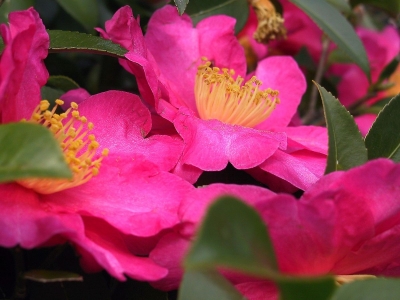
The common camellia (C. japonica) is well known, particularly for its double (many-petaled) cultivated varieties, whose overlapping petals range in colour from white through pink to red and variegated. In the wild form, five to seven petals surround a mass of yellow stamens, with sepals dropping as the petals open. The tree has glossy green oval leaves, usually about 10 cm (4 inches) long, and reaches a height of about 9 metres (30 feet).
C. sinensis is native to East Asia, the Indian Subcontinent, and Southeast Asia, but it is today cultivated across the world in tropical and subtropical regions. It is an evergreen shrub or small tree that is usually trimmed to below 2 m (6.6 ft) when cultivated for its leaves. It has a strong taproot. The flowers are yellow-white, 2.5–4 cm (0.98–1.57 in) in diameter, with seven or eight petals.
The seeds of C. sinensis and C. oleifera can be pressed to yield tea oil, a sweetish seasoning and cooking oil that should not be confused with tea tree oil, an essential oil that is used for medical and cosmetic purposes, and originates from the leaves of a different plant.
Picture Credit : Google



